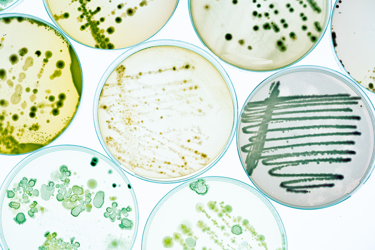Genetically sequencing environmental contaminations gives data-driven results of an isolate’s species.

Environmental sampling and microbial surveillance are key factors in maintaining clean environments and ensuring product sterility. Escaping microbes is nearly impossible, but knowing the identity of an organism helps recognize when and how to take the proper preventative measures. Whether you are interested in product manufacturing, research & development, or knowing points of vulnerability within your service, trust Microchem to keep you and your environment safe by accurately identifying your contaminations. Microchem identifies microorganisms by genetically sequencing DNA and comparatively analyzing the results. Being a more modern approach, genetically identifying microbes renders a species’ taxa with great confidence and accuracy, whereas more traditional methods offer a suggestion.
Traditional Microbial Identification Methods:
Traditional microbial identification processes rely on phenotypic analysis. Morphology patterns, staining, and biochemical tests are common and less costly methods scientists use to distinguish an organism’s identity.
Morphology Patterns:
Our lab analysts have great experience identifying organisms based on their morphology. When isolating a microbe, a sample is swabbed and cultured onto a petri dish. Once the incubation period is over, the petri dish often shows visible growth to the naked eye. Bacteria form individual colonies and have distinct odor and color. Fungi and mold can often look hairy and have irregularly shaped growth. On rare occasions, same species organisms can have different types of growth based on the environment they inhabit. Because of this, further identification methods are often utilized to ensure the species’ identity.
Staining:
Scientists often use simple staining as another method to differentiate organisms. Microbes are analyzed under a microscope using chemical dyes once it is smeared and heat-fixed onto a glass slide. Crystal violet, methylene blue, eosin, or nigrosin dye the microbe, allowing its properties to be colored and seen. A common simple stain is gram staining, which targets the peptidoglycan in a bacteria’s cell walls. Crystal violet binds to the large amount of peptidoglycan in Gram-positive bacteria, staining it purple. Gram-negative microbes do not have a large amount of peptidoglycan for the crystal violet to bind to, so they lose their stain during the decolorization step. This process allows our lab to minimize the potential possibility of a microbe’s identity by indicating its molecular structure. Although simple stains help group bacteria, only an inference can be drawn on the species of the microbe.
Biochemical Tests:
Another traditional method to identifying a microbe is through biochemical tests. Analysts use biochemical tests to identify an organism by viewing the physical and chemical reaction that occurs when a microbe comes into contact with certain substances. A reaction may result in a change in a liquid medium’s turbidity or a change in pH level. Although biochemical tests can be more selective in identifying organisms, growth and reaction time may take a few days for proper results.
Our lab has advanced experience in isolating microbes through traditional methods. We can identify an organism, with confidence, using the three methods described above. However, genetic testing can give an exact, computer-backed species identity with a percentage of accurate results. Genetic DNA sequencing complement and strengthen our analysts’ visual findings.
Genetic Sequencing:
Genetic sequencing a microbes DNA is considered the gold standard  for microbial identification. Microchem genetically sequences bacterial and fungal isolates by using the Sanger Sequencing method and comparatively analyzing the results to the MicroSEQ ID library, containing over 20,000 validated species. Genetic sequencing allows us to know the exact DNA of a microbe. Industries need the exact species of a microbe to know the proper measures required for growth mitigation and infection prevention. Microbial DNA sequencing is the most accurate and sure way to maintain safety and sterility in your environment.
for microbial identification. Microchem genetically sequences bacterial and fungal isolates by using the Sanger Sequencing method and comparatively analyzing the results to the MicroSEQ ID library, containing over 20,000 validated species. Genetic sequencing allows us to know the exact DNA of a microbe. Industries need the exact species of a microbe to know the proper measures required for growth mitigation and infection prevention. Microbial DNA sequencing is the most accurate and sure way to maintain safety and sterility in your environment.
